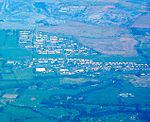Drumgelloch railway station
Airdrie, North LanarkshireFormer North British Railway stationsPages with no open date in Infobox stationRailway stations in Great Britain closed in 1956Railway stations in Great Britain opened in 1862 ... and 6 more
Railway stations in Great Britain opened in 2011Railway stations in North LanarkshireRailway stations served by ScotRailReopened railway stations in Great BritainSPT railway stationsUse British English from August 2017

Drumgelloch railway station is a railway station serving the east of Airdrie, North Lanarkshire, Scotland. It is located 600 yards (550 m) east of the 1989 station on the former Bathgate and Coatbridge Railway, on the site of the former Clarkston railway station. The station previously closed in 1956.
Excerpt from the Wikipedia article Drumgelloch railway station (License: CC BY-SA 3.0, Authors, Images).Drumgelloch railway station
Old Bore Road,
Geographical coordinates (GPS) Address Nearby Places Show on map
Geographical coordinates (GPS)
| Latitude | Longitude |
|---|---|
| N 55.867 ° | E -3.9501 ° |
Address
Old Bore Road
Old Bore Road
ML6 7AQ , Petersburn
Scotland, United Kingdom
Open on Google Maps




